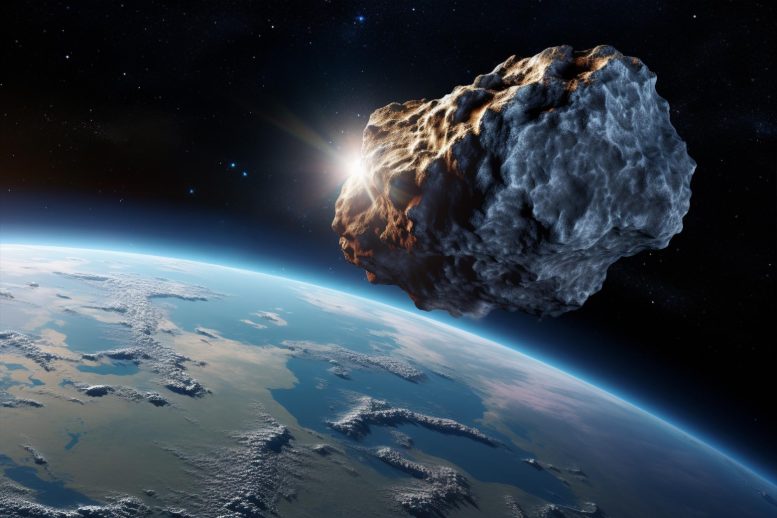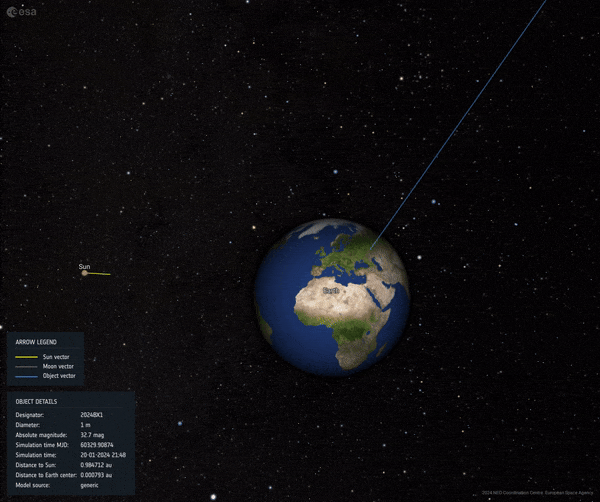
The Scouting System's prediction of asteroid 2024 BX1's impact on Germany highlights the effectiveness of NASA's planetary defense capabilities. The asteroid was discovered just 95 minutes before it entered Earth's atmosphere, and disintegrated harmlessly, demonstrating the increasing accuracy of near-Earth object (NEO) tracking systems. (Artist's concept.) Credit: SciTechDaily.com
NASAScout's detection system accurately predicted the impact of asteroid 2024 BX1 on Germany, showcasing advances in planetary defense by detecting and tracking small, harmless asteroids before they enter Earth's atmosphere.
The Scout Impact Evaluation System calculated where and when asteroid 2024 BX1 would impact Earth's atmosphere, providing a useful demonstration of the planetary defense capability.
A small asteroid about 3 feet (1 meter) in size disintegrated over Germany on Sunday, January 21 at 1:32 a.m. local time (CET). 95 minutes before it collides with the Earth's atmosphere, NASA scout The Impact Risk Assessment System, which monitors data on potential asteroid discoveries, gave advance warning of where and when the asteroid would strike. This is the eighth time in history that a small asteroid heading for Earth has been discovered while it is still in space, before it enters and disintegrates in our atmosphere.
The asteroid impact produced a bright fireball (see video below), or meteor, which was seen from as far away as the Czech Republic and may have scattered small meteorites on Earth at the impact site about 37 miles (60 kilometers) west of Berlin. . The asteroid was later named 2024 BX1.

This map shows the location where the small asteroid 2024 BX1 impacted Earth's atmosphere above Germany, about 37 miles (60 kilometers) west of Berlin, on January 21. NASA's system, called Scout, predicted the impact time and location within one second and about 330 feet (100 meters). Image source: NASA/JPL-Caltech
While NASA reports on near-Earth objects (NEOs) of all sizes, the agency is tasked by Congress with detecting and tracking NEOs 140 meters or larger that could cause significant damage to Earth if they collide with our planet. These objects can be detected much earlier than small objects such as 2024 BX1.
Small asteroids like this impact our planet from time to time. They pose no threat to life on Earth but could provide a useful demonstration of what NASA is doing Planetary defense Capabilities like Quick Response Path Calculation and Scout Impact Alerts.
How was it predicted?
Asteroid 2024 BX1 was first observed less than three hours before its impact by Krysztian Szarnieczky at the Konkoli Observatory's Pieszkistito mountain station near Budapest, Hungary. These early notes It has been reported to Minor planet center – The internationally recognized information exchange center for measurements of the positions of small objects in the solar system – and is automatically published on the center NEO confirmation page So other astronomers can make additional observations.
Scout, which was developed and operated by the Center for Near-Earth Object Studies (Sinus) at NASA's Jet Propulsion Laboratory in Southern California automatically fetched new data from that page, inferring the object's likely path and chances of hitting Earth. CNEOS calculates the orbit of every known near-Earth object to provide assessments of potential impact risks for the Planetary Defense Coordination Office (PDCO Company) at NASA headquarters in Washington.
Late in the evening of January 20, 2024, astronomer Christian Sarnitsky discovered an asteroid on an imminent collision course with Earth. Just hours later, it struck our planet's atmosphere 50 kilometers west of Berlin, producing this stunning fireball at 01:32 CET, Sunday 21 January. Later named 2024 BX1, it is the eighth asteroid observed by humanity before the impact. Thanks to the rapid response and information-sharing from the asteroid and fireball communities on Earth, including ESA's Near-Earth Object Coordination Centre, many people were able to see and record this amazing spectacle, despite it occurring only hours after notice and in the middle of the night. . the night. This video was captured by AllSky7 Network. Credit: ALLSKY7/Circo Molau – AMS16 Kitzur
By posting three notes on the confirmation page within 27 minutes, Scout initially determined that impact was possible and that additional notes were urgently needed. As astronomers across Europe reported new data to the Minor Planet Center, the asteroid's path became better known and the probability of it colliding with Earth increased dramatically.
Seventy minutes after 2024 BX1 was first observed, Scout reported a 100% probability of hitting Earth and began narrowing down the location and time. As tracking continued and more data became available over the next hour, Scout improved his time and location estimates. Since the asteroid disintegrated over a relatively populated part of the world, numerous photos and videos of the fireball have been posted online minutes after the event.

Visualization of the path and impact of asteroid 2024 BX1 on January 21, 2024, created using the Flyby visualization tool of the European Space Agency's Near-Earth Object Coordination Centre. Credit: ESA, CC BY-SA 3.0 IGO
Tracking near-Earth objects
The first asteroid to be discovered and tracked before it collided with our planet was 2008 TC3Which entered our atmosphere and exploded over Sudan in October 2008. That 13-foot-wide (4-meter) asteroid scattered hundreds of small meteorites over the Nubian Desert.
In early 2023, another small asteroid was identified 2023 CX1It was discovered seven hours before it entered the Earth's atmosphere over northwest France. As with 2024 BX1, Scout accurately predicted the location and time of impact.
As NEO surveys become more sophisticated and sensitive, more of these harmless objects are being detected before they enter our atmosphere, providing real-world exercises for NASA's planetary defense program. Details gathered from such events help inform the agency Mitigation strategies In the event that a large and dangerous object is discovered on a collision course with our planet in the future.

“Beer aficionado. Gamer. Alcohol fanatic. Evil food trailblazer. Avid bacon maven.”
